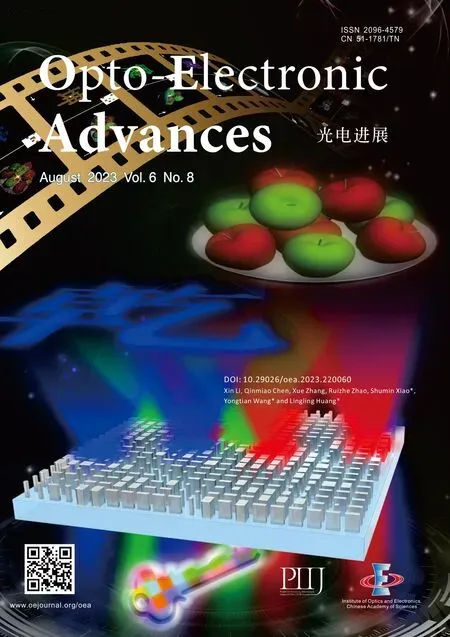Advancing nonlinear nanophotonics: harnessing membrane metasurfaces for third-harmonic generation and imaging
Mingbo Pu and Xiangang Luo
In recent years, the field of nonlinear nanophotonics has experienced significant growth, drawing substantial attention due to its wide range of applications1. These applications encompass ultrasensitive sensing, optical microscopy2, quantum metasurfaces3, integrated photonics4,optical information security5and the generation of entangled photon pairs6. This surge in interest is closely linked to advancements in the growth and nano-fabrication of nonlinear materials7,8, which have established metasurfaces as a versatile platform for nanoscale nonlinear processes. The interaction between light and matter within subwavelength resonators in metasurfaces enables the amplification of effective nonlinearities, surpassing what can be achieved in bulk materials5,9-10. This amplification is attributed to the control of optical performance through symmetry and parametric tuning.Contemporary research has substantiated the concept of enhanced nonlinear generation at the nanoscale across diverse processes such as second-harmonic generation11,third-harmonic generation, and four-wave mixing.These nonlinear processes are demonstrated through resonant dielectric metasurfaces such as AlGaAs, GaAs,LiNbO3, and Si metasurfaces. The critical factor in achieving potent light-matter interactions and heightened nonlinear signal intensity is the confinement of light within these metasurfaces.
An innovative approach that has recently gained prominence for manipulating light-matter interactions is the concept of bound states in the continuum (BICs)12.Originating from quantum mechanics, BICs find applications in metasurfaces and nonlinear generation, facilitating controlled light confinement within resonators.Notably, conventional dielectric metasurfaces comprising subwavelength resonators exhibit pronounced light confinement proximal to the resonators. In recent years,membrane metasurfaces, characterized by a single layer of nonlinear material punctuated by an array of perforations, have exhibited distinctive optical attributes compared to conventional dielectric metasurfaces featuring nanoparticle arrays. This characteristic expands the practical utility of membrane metasurfaces, especially holding promise for enhancing spatial resolution in imaging.Additionally, guided modes play a pivotal role in membrane metasurfaces, broadening options for manipulating light-matter interactions, particularly within nonlinear nanophotonics.
Within this context, researchers led by Mohsen Rahmani, and Lei Xu proposed an innovative application of silicon membrane metasurfaces to advance the third-harmonic generation (THG) process13. The proposed membrane metasurfaces, characterized by dimer holes, exhibit support for multiple symmetry-protected BICs.Through strategic tuning of the gap between these holes,they can transform symmetry-protected BICs into quasi-BICs, resulting in strong electromagnetic field confinement within the silicon membrane via plane-wave illumination. Membrane metasurfaces present a unique advantage by concurrently supporting multipolar resonances, maintaining small unit sizes, and offering highmode volume-attributes that hold promise for enhancing nonlinear frequency conversion compared to conventional particle-based metasurfaces.

Fig. 1 | (a) THG imaging based on Si membrane metasurfaces: the near-infrared signal passes through the target, then being converted into the visible signal via the metasurfaces, forming the target image on the CCD camera. (b1-e1) The images of the target and the metasurfaces under white light source illumination. (b2-e2) Transformed visible images of the target via membrane metasurfaces under NIR light illumination.13
Their research group also illuminated the intricacies underlying the genesis of BICs, harnessing the tenets of structural symmetry and a multipolar model. By adeptly manipulating the parameter of offset, they effectuate the metamorphosis of an ideal BIC into a quasi-BIC. This intricate phenomenon is explicated through the lens of structural symmetry. Although this exposition concisely encapsulates the BIC's formation, it somewhat overlooks the intricate dynamics governing the transference of energy between the bound modes and external modes. To elaborate, the team subsequently embarked on an exploration and characterization of these modes via spherical and Cartesian multipolar analysis. This analytical approach enables a vantage point conducive to the comprehension of these modes' transformation through the prism of multipolar metamorphosis, manifesting discernibly as a Fano feature within the optical response spectrum.
Their study has successfully showcased the experimental results of membrane metasurfaces for achieving the upconversion of infrared (IR) images into visible wavelengths through the process of THG, leveraging silicon (Si) material as the foundation. By finely adjusting the parameters, they have effectively transformed symmetry-protected BICs into resonances of the quasi-BIC category, characterized by an infinite Q-factor. They have elucidated the intricate formation mechanisms of these BICs, drawing insights from both symmetry considerations and multipolar analyses and consistent with their theoretical models.
Following thorough testing and comprehensive characterization of the fabricated samples, the research team has unveiled the prospective application of their enhanced THG technique, centered on silicon membrane metasurfaces, in the field of IR imaging. The incorporation of membrane metasurfaces brings an additional advantage by enhancing nonlinear generation capabilities.This augmentation arises from the metasurfaces' intrinsic ability to provide a more compact unit size while simultaneously expanding the mode volume within the nonlinear material. This fortification of nonlinear generation widens the horizon of potential applications, particularly in the domains of all-optical infrared imaging in ambient conditions and the pursuit of nonlinear spectroscopy endeavors.
In the context of infrared (IR) imaging and spectroscopy, nonlinear metasurfaces emerge as a promising alternative to conventional commercial IR imaging detectors. This arises from their remarkably compact nature and the reduced complexity of signal conversion components. Significant strides have been achieved using GaAs nanoantennas and Si nanopillars as exemplars. The focal point here lies in the enhancement of the efficiency of nonlinear generation conversions, as it stands as a pivotal element in realizing the tangible utility of IR imaging advancements.
Acknowledgements
We are grateful for financial supports from Chinese Academy of Science Project xbzg-zdsys-202206.
 Opto-Electronic Advances2023年8期
Opto-Electronic Advances2023年8期
- Opto-Electronic Advances的其它文章
- A novel method for designing crosstalk-free achromatic full Stokes imaging polarimeter
- Cover
- Time-sequential color code division multiplexing holographic display with metasurface
- Third-harmonic generation and imaging with resonant Si membrane metasurface
- Direct field-to-pattern monolithic design of holographic metasurface via residual encoderdecoder convolutional neural network
- Planar peristrophic multiplexing metasurfaces
